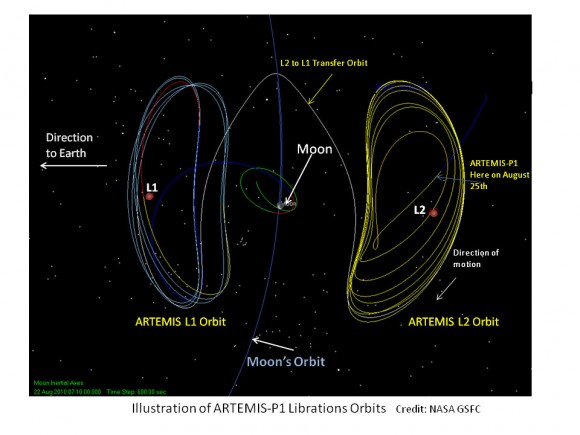Two of the Themis satellites - which studied the Earth's magnetosphere became Artemis - and study the lunar magnetic field and its relationship with the solar wind

In another case of recycling and reusing spacecraft, NASA is removing two of the five Themis spacecraft - which investigate the source of geomagnetic storms on Earth - for a new mission.
The two spacecraft performed complicated maneuvers to reach two different Lagrange points between the Earth and the Moon, where they would focus on the Moon. In particular, they will try to determine how the solar wind electrifies, modifies and erodes the lunar surface. This follows the discovery a year ago of water at various sites on the surface of the moon, and how it interacts with the solar wind.
The original THEMIS (Time History of Events and Macroscale Interactions during Substorms) mission consisted of five satellites that completed a successful two-year mission. As they continue to work well, NASA decided to re-purpose two of the spacecraft in a special orbit around the moon. The new mission will be called ATRHEMIS - Acceleration, Reconnection, Turbulence and Electrodynamics of the Moon's Interaction with the Sun.
The conversion of the orbit took over a year, and required almost all the fuel left on the satellites to bring them to the Lagrange points L1 and L2, where one of them will be located above the far side of the Moon and the other - above the side facing the Earth. Artemis P1 is the first spacecraft to launch and will perform stabilization operations around the L1 and L2 points. On August 25, Artemis P1 reached the L2 point on the far side of the Moon. Artemis P2 entered the opposite point – L2 on October 22. Recently one of the spaceships was hit by a meteorite but it seems to be functioning.
When the moon orbits the earth, it crosses back and forth through the earth's magnetic field and encounters a stream of solar wind particles at a speed of about one and a half million kilometers per hour. While in these areas, two Artemis spacecraft will search for evidence of eddies, particle acceleration and magnetic reconnection, three fundamental phenomena that govern the nature of interactions between the solar wind and Earth's magnetosphere.
Using their instruments and the key points where they are located, the spacecraft will investigate the void created by the moon when it cuts through the solar wind and the processes that eventually fill that void. Closer to the moon, the spacecraft will encode, under the influence of the magnetic field of the surface, the ions that are reflected from the lunar surface and determine the internal structure of the moon by measuring the changes in the magnetic field caused by the external changes.

3 תגובות
Arnon:
You didn't follow what was said in the video.
The satellites will obviously stay for a few months in the vicinity of the Lagrange points and only later will they move to new orbits around the moon.
Here is a quote starting one minute and five seconds into the movie:
For a few months, the spacecrafts don't even orbit the earth or the moon. Instead, they circle the two locations where the gravity of the earth and the moon cancel out exactly. These spots, just inside and just beyond lunar orbit are known as Lagrange points.
The method of turning the orbit around the moon - genius for its own sake!!!!!
It is interesting how many computer simulations were performed when reaching the final result.
Response to 1:
The mistake is probably in the original article, it is clear from the video that the satellites do not stay in L1 and L2 they orbit the moon. Maybe they cross these points at the same time.
Review
It is not relevant to explain in the article about points L1 and L2 that the drawing cannot be seen!
At the same time, the video really illustrates the complexities involved.